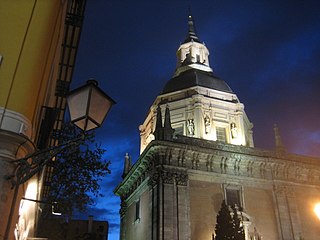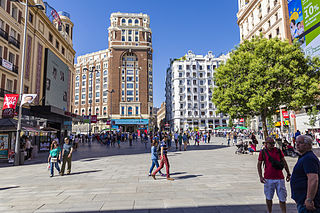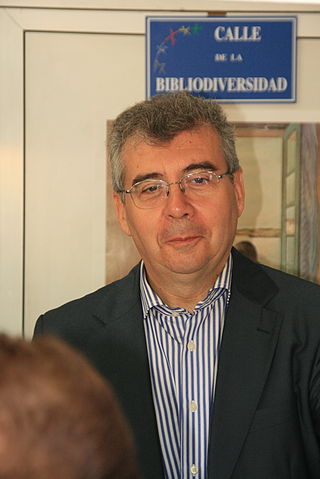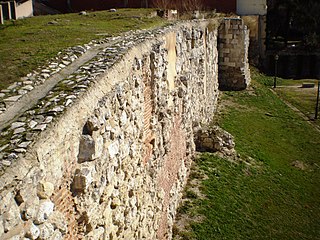
El Madrid de los Austrias is a name used for the old centre of Madrid, built during the reign of the Habsburg Dynasty (1516–1700), known in Spain as Casa de Austria. The area is located south of the Calle Mayor, in between the Metro stations Sol and Ópera.

Mariano Benlliure y Gil was a Spanish sculptor and medallist, who executed many public monuments and religious sculptures in Spain, working in a heroic realist style.

Ciudad Colonial is the historic central neighborhood of the Dominican Republic's capital Santo Domingo. It is the oldest continuously inhabited European-established settlement in the Americas. The area has been declared a World Heritage Site by UNESCO. It is also known as Zona Colonial or more colloquially as "La Zona".

The main components of the Coat of arms of Madrid have their origin in the Middle Ages. The different coats of arms have experienced several modifications, losing for example motifs often displayed in early designs such as water and flint.

The Casa de la Panadería is a municipal and cultural building on the north side of the Plaza Mayor in Madrid. It is four stories high, the ground floor comprising porticos and the top floor in the form of an attic, with its sides crowned by angular towers.

The Church of San Andrés is a church in Madrid, Spain. It was declared a Bien de Interés Cultural in 1995.
Muley Xeque was a Moroccan prince, born in Marrakech in 1566 and died in Vigevano in 1621. Exiled in Spain, he converted to Catholicism in Madrid and was known as Felipe de África, Philip of Africa or Philip of Austria, in addition to the nickname of The Black Prince.

The Convento del Carmen Calzado was a convent in the Order of Mount Carmel. It was located in the area currently occupied by the Plaza del Carmen in Madrid. This convent was founded in 1573. The Spanish confiscation during the late 19th century left only the Parish church del Carmen and the ensanche (widening) of the area of Plaza del Carmen. One of the ten streets leading to the Puerta del Sol, and passing next to the facade of the parish church, is called Calle del Carmen. The site of the convent was dedicated to the Frontón Central, which would become the Cine Madrid.
The Palacio del Marqués de Casa Riera was the name for two successive buildings located in the same place, in the Spanish city of Madrid, in the number 64 of the Calle de Alcalá, it was in the widest part of the street.

The Walls of Madrid are the five successive sets of walls that surrounded the city of Madrid from the Middle Ages until the end of the 19th century. Some of the walls had a defensive or military function, while others made it easy to tax goods entering the city. Towards the end of the 19th century the demographic explosion that came with the Industrial Revolution prompted urban expansion throughout Spain. Older walls were torn down to enable the expansion of the city under the grid plan of Carlos María de Castro.

Roman villa of Camino de Albalate is a Roman site near Calanda, Teruel, Aragon, Spain. The archaeological site, now dismantled, is located in the Albalate orchard area and is one of the most significant sites in the province of Teruel. The mosaic discovered there stands as the primary example of Roman culture in the aforementioned province.

The Callao Square is located at the centre of the Spanish capital of Madrid.

Pedro Montoliú Camps is a Spanish journalist who was named a Chronicler of the Villa de Madrid in 1999.

The Casa de la Villa is a building located in Madrid, Spain. It served as city hall from the 17th to the 21st century.

The Monument to Álvaro de Bazán is an instance of public art in Madrid, Spain. Located at the Plaza de la Villa, it consists of a bronze sculpture designed by Mariano Benlliure representing Álvaro de Bazán—a noted 16th century Admiral of the Spanish Navy once described by Cervantes as "father of soldiers, lightning of war, fortunate and never defeated captain"— put on top of a stone pedestal.

The Praza da Ferrería is a large square located on the edge of the old town of Pontevedra (Spain), inside the old city walls. It is the main square of the old town and has an area of about 2,000 m2. It includes the small squares of the Estrella on the north side, the Orense square on the south side and the Casto Sampedro square on the east side, making a total of almost 5,000 m2.
Colegas is a Spanish dramedy streaming television series directed by Peris Romano which stars Manuel Feijóo, Julián González, Lara de Miguel, Fernando Gil and Marta Solaz, among others. Produced by RTVE Digital and Hill Valley Producciones, it was released from 2017 to 2018 on playz.

The Tower of Narigües was an albarrana tower in Madrid. Its remains are along the old Muslim wall of Madrid. Located at 83 Calle Mayor, next to the Segovia Viaduct that crosses Calle de Segovia. It was separated from the wall itself, but joined to it through another wall. It served as a watch tower.

The Arrabal of Saint Martin was a medieval arrabal (neighborhood) that sat outside the Christian Walls of Madrid. It was located around the location of the current Plaza of San Martín, and occupied the space between Calle del Arenal, the Plaza de las Descalzas, Plaza del Callao, and Calle de las Navas de Tolosa. It grew as a population center around the Monastery of Saint Martin, neighboring San Martín was the Arrabal of San Ginés, and both were absorbed by the growth of the city in the 17th century.

The history of the Puerta del Sol represents an essential part of the memory of the Villa de Madrid, not only because the Puerta del Sol is a point of frequent passage, but also because it constitutes the "center of gravity" of Madrid's urban planning. The square has been acquiring its character as a place of historical importance from its uncertain beginnings as a wide and impersonal street in the sixteenth century, to the descriptions of the first romantic travelers, the receptions of kings, popular rebellions, demonstrations, etc. It has been the scene of major events in the life of the city, from the struggle against the French invaders in 1808 to the proclamation of the Second Republic in 1931, and it has also retained its place as the protagonist of the custom of serving Twelve Grapes on New Year's Eve, to the sound of the chimes struck by the Correos clock. Nowadays it is a communications hub, a meeting point, a place of appointments, a place for celebrations and the beginning of demonstrations in the Capital.



















